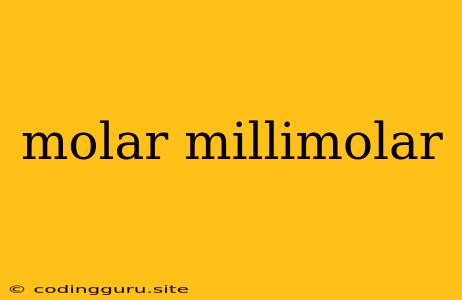Understanding Molarity and Millimolarity: A Guide to Concentration
In the realm of chemistry, understanding the concentration of solutions is crucial for conducting experiments, analyzing reactions, and formulating accurate predictions. Two commonly used units of concentration are molarity and millimolarity. While these terms might seem similar, there is a subtle difference that holds significant implications for calculations and applications.
What is Molarity?
Molarity (M) is a measure of concentration that represents the number of moles of solute dissolved in one liter of solution. In simpler terms, it tells you how much of a substance is packed into a given volume of liquid.
For example: A 1 M solution of sodium chloride (NaCl) contains one mole of NaCl dissolved in one liter of water.
What is Millimolarity?
Millimolarity (mM) is a closely related unit of concentration, but it uses millimoles instead of moles. One millimole is equal to 1/1000 of a mole. Therefore, a 1 mM solution contains one millimole of solute dissolved in one liter of solution.
For example: A 1 mM solution of glucose (C6H12O6) contains one millimole of glucose dissolved in one liter of water.
Why Use Millimolarity?
While molarity is a widely used unit, millimolarity is often preferred in situations where dealing with smaller concentrations is more practical. This is particularly common in fields like:
- Biochemistry: Many biological reactions involve very small concentrations of molecules, making millimolarity a more convenient unit to work with.
- Analytical Chemistry: Experiments involving trace amounts of substances often utilize millimolar concentrations.
- Pharmacology: Drug dosages and concentrations are frequently expressed in millimolar terms.
Converting Between Molarity and Millimolarity
Converting between molarity and millimolarity is a simple process that involves a factor of 1000. To convert from molarity to millimolarity, multiply by 1000. To convert from millimolarity to molarity, divide by 1000.
For example:
- A 0.5 M solution is equivalent to 500 mM (0.5 M x 1000 = 500 mM).
- A 25 mM solution is equivalent to 0.025 M (25 mM / 1000 = 0.025 M).
Tips for Using Molarity and Millimolarity:
- Always pay attention to the units used in a problem or calculation.
- Use the appropriate conversion factor when switching between molarity and millimolarity.
- Double-check your calculations to avoid errors.
Conclusion:
Understanding the difference between molarity and millimolarity is essential for anyone working with solutions in a scientific setting. By understanding these concentration units and how to convert between them, you can ensure accurate calculations and interpretations of your experiments and results.
